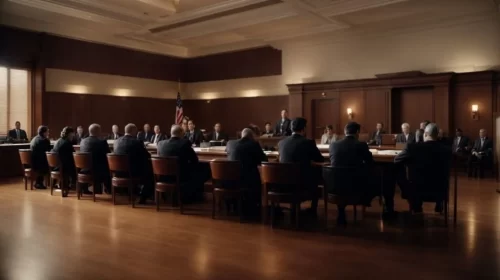
 Patent | January 13, 2025 | Comments
Patent | January 13, 2025 | Comments
What Is Patent Litigation?
Patent litigation is a complex legal process that involves resolving disputes related to intellectual property rights.
This article will provide you with a comprehensive overview of the basics of patent litigation, its importance in protecting intellectual property rights, the key players involved, the process of litigation from filing a complaint to trial, and important factors to consider, such as evidence of infringement and damages.
Stay tuned to learn more about this critical aspect of the legal field.
Key Takeaways:
- Patent litigation is a legal process used to resolve disputes over the ownership and infringement of patents, which are exclusive rights granted to inventors for their inventions.
- Patent litigation is important for protecting intellectual property rights and resolving disputes between patent holders and alleged infringers.
- Key players in patent litigation include the patent holder, defendant, and legal representatives, and the process involves filing a complaint, discovery, pre-trial proceedings, and a trial.
Introduction to Patent Litigation
Introduction to Patent Litigation explores the legal process in which patent rights are enforced through litigation in court, involving parties such as plaintiffs, defendants, and the USPTO.
Patent litigation typically involves several key stages, starting with the plaintiff filing a complaint against the defendant for patent infringement. The defendant then responds with their answer, often asserting defenses such as invalidity or non-infringement.
Throughout the process, both parties exchange evidence, engage in discovery, and attempt settlement negotiations. If the case proceeds to trial, the court plays a crucial role in interpreting patent law, determining the validity of the patent, and evaluating the alleged infringement.
Understanding the Basics
Understanding the Basics of Patent Litigation involves grasping the legal concepts regarding patent infringement, trial procedures, expert testimonies, and the nuances of district court cases.
Regarding patent infringement claims, they usually revolve around the alleged use, manufacture, or sale of a patented invention without permission. Trial preparations demand meticulous attention to detail, including gathering evidence, preparing witnesses, and formulating legal strategies.
Expert opinions play a crucial role in patent litigation, often determining the technical validity of an invention or the scope of protection it should receive. District courts, as the primary trial courts for patent disputes, play a significant role in resolving these legal issues with their expertise in patent law.
Importance of Patent Litigation
The Importance of Patent Litigation lies in safeguarding intellectual property rights, resolving disputes, and establishing competitive advantages in sectors like pharmaceuticals and software through strategic patent enforcement.
Patent litigation plays a crucial role in safeguarding the rights of inventors and innovators by providing legal protection against infringement and unauthorized use of their creations. By enforcing patents, companies not only protect their innovations but also gain a competitive edge in the market by limiting the entry of competitors who may try to copy or exploit their intellectual property.
Strategic patent enforcement is essential for companies operating in highly competitive industries like pharmaceuticals and software, where technological advancements are rapid and closely guarded. Through targeted patent litigation, organizations can ensure that their investments in research and development are secured, and their intellectual property is respected and valued by competitors and the market at large.
Protecting Intellectual Property Rights
Protecting Intellectual Property Rights through patent litigation involves leveraging legal mechanisms to defend innovations, secure patents, and uphold proprietary technologies in competitive sectors like pharmaceuticals and software.
Patent litigation plays a crucial role in safeguarding proprietary technologies and innovations from infringement, piracy, and unauthorized use. In today’s fast-paced business landscape, securing patents is essential for companies to protect their ideas and inventions, ensuring a competitive edge in the market. By litigating patents, companies can deter competitors from copying their technology, thereby preserving their market share and revenue streams. Patent litigation serves as a strategic tool to enforce intellectual property rights, discouraging intellectual property theft and fostering innovation.
Resolving Disputes
Resolving Disputes through patent litigation entails navigating legal proceedings, presenting evidence, and seeking damages in cases adjudicated by district courts or juries, mediated by the USPTO.
Patent disputes often arise when two parties claim ownership over an invention or intellectual property, leading to legal battles to establish rights and ownership. During evidence presentation, detailed documentation, technical reports, expert testimonies, and prior art references play a crucial role in supporting each party’s claims. Damage claims in patent litigation involve calculating financial losses due to alleged patent infringement, requiring thorough analysis and assessment. Court proceedings involve pre-trial motions, discovery, hearings, and ultimately a trial where attorneys advocate for their respective clients’ positions.
Key Players in Patent Litigation
Key Players in Patent Litigation encompass patent holders, defendants, and legal representatives who navigate the intricacies of court processes, technology claims, and trial proceedings.
Patent holders play a crucial role in asserting their exclusive rights over the patented technology, defending against infringement claims, and strategizing to protect their intellectual property. On the other side, defendants need to mount a defense against allegations of patent infringement, challenging the validity of the patent in question, and presenting their arguments to refute the claims. Legal counsels for both parties are responsible for crafting trial strategies, preparing technological arguments, conducting legal research, and representing their clients’ interests throughout the litigation process.
Patent Holder
The Patent Holder in patent litigation represents the entity possessing patent rights, leveraging legal actions to protect innovations and secure competitive advantages in industries like pharmaceuticals and software.
In the realm of patent litigation, these holders play a crucial role by safeguarding their intellectual property and shaping the market’s competitive landscape. Their patent portfolios, comprising a range of protected technologies, serve as valuable assets that demonstrate their commitment to innovation and advancement in their respective sectors. Through strategic enforcement of their patents, they establish a strong foothold in the industry, deterring potential infringements and ensuring their market position remains robust and influential.
Defendant
The Defendant in patent litigation responds to claims of infringement, presenting defenses based on prior art, technological evidence, and legal arguments to secure favorable verdicts in jury trials or court judgments.
Defendants play a crucial role in patent cases by meticulously crafting defense strategies that aim to invalidate the plaintiff’s claims of infringement. They often rely on prior art to demonstrate that the patented technology was not novel or non-obvious at the time of filing. By showcasing a thorough understanding of the technological evidence and looking into intricate legal arguments, defendants aim to persuade juries or judges of their innocence.
In the dynamics of a jury trial, defendants must effectively communicate complex technical details in a manner that is easily understandable to non-experts. This involves breaking down intricate concepts, such as patent claims and validity, to present a compelling defense. The outcome of a patent case heavily relies on the jury’s comprehension of the evidence presented by both parties and their assessment of the validity of the arguments put forth.
Legal Representatives
Legal Representatives in patent litigation encompass trial counsels, appellate attorneys, and legal experts who navigate the nuances of court proceedings, jury trials, and complex appeals in district and appellate courts.
In patent cases, trial counsel plays a crucial role in developing trial strategies that effectively present complex technical information in a manner understandable to a judge and jury. Their expertise extends to pre-trial motions, evidentiary presentations, and cross-examination techniques aimed at establishing the validity or infringement of patents.
During jury interactions, legal representatives must artfully communicate their arguments, utilizing persuasive skills to sway the jury’s understanding and secure a favorable verdict. They meticulously prepare for the courtroom, anticipating opposing counsel’s moves and adjusting their approach in real-time to address challenges.
Appellate attorneys specialize in crafting written briefs and presenting oral arguments before appellate courts, focusing on legal precedent, case law, and constitutional issues that can influence the outcome of the appeals process. Their attention to detail and sharp analytical skills are instrumental in presenting a strong case for clients.

Process of Patent Litigation
The Process of Patent Litigation unfolds through stages such as filing complaints, discovery phases, pre-trial preparations, and courtroom trials, driven by technological evidence and jury assessments.
Once the complaint is submitted, the defendant must respond within a specified timeframe, outlining relevant counterarguments and defenses. This exchange sets the foundation for the discovery phase, where both parties gather and exchange evidence, including documents, witness testimonies, and expert reports.
Following the evidence collection, the pre-trial preparation begins, during which legal teams strategize, analyze potential outcomes, and establish arguments to present in court. This phase involves identifying key witnesses, practicing deposition techniques, and formulating compelling narratives.
Filing a Complaint
Filing a Complaint in patent litigation initiates legal actions, outlining infringement claims, technological details, and case specifics for presentation in district courts under the guidance of trial counsels.
When initiating legal proceedings in patent disputes, the complaint serves as the foundation of the case, articulating the alleged violations and the unique aspects of the patented technology at stake. The formulation of these claims demands precision and clarity, as they determine the scope of protection sought. The case particulars detailed in the complaint, including the patent registration details and the alleged infringing activities, establish the crux of the legal argument.
Discovery Phase
The Discovery Phase in patent litigation involves evidence collection, expert testimonies, and prior art assessments to support legal arguments and technological claims in courtroom proceedings.
During the evidence collection process, both tangible and intangible proofs are gathered, ranging from laboratory experiments to email correspondences to establish the chain of events. Expert consultations play a crucial role in dissecting complex technical details and providing insights that can strengthen legal arguments.
The examination of prior art involves a meticulous review of existing patents, publications, and other public disclosures to determine the novelty of the invention in question. These activities not only fortify the legal positions of the parties involved but also contribute significantly to the overall success of the patent litigation process.
Pre-trial Proceedings
Pre-trial Proceedings in patent litigation encompass case management, legal briefings, and procedural preparations to ensure courtroom readiness and procedural adherence in district court settings.
Case organization in patent litigation involves scheduling conferences, setting deadlines, and clarifying legal issues to streamline the forthcoming trial process. These proceedings also entail the submission of detailed legal briefs outlining the parties’ arguments, legal authorities, and evidence in support of their case.
Effective management of complexities, such as technical terminology or scientific evidence, is crucial in presenting a clear and persuasive case to the court. Attorneys need to meticulously navigate through the intricate web of patent laws and regulations to present a convincing argument.
Trial
The Trial phase in patent litigation involves jury evaluations, technological demonstrations, legal arguments, and verdict determinations that culminate in judicial decisions impacting the involved parties and their technological claims.
During this crucial phase, the courtroom becomes a battleground where legal teams present their cases precisely and persuasively. Jurors, often a mix of individuals with varying backgrounds, are tasked with understanding complex technical details to make well-informed decisions. Technological showcases play a vital role, as both parties strive to demonstrate the uniqueness and inventiveness of their respective innovations. Each presentation serves as a chess move in the intricate game of patent litigation, aiming to sway the jury in favor of their arguments.
Factors to Consider in Patent Litigation
Factors to Consider in Patent Litigation encompass assessments of infringement evidence, patent validity, damage claims, and cost evaluations crucial to determining legal outcomes in technology-related cases.
Assessing the strength of infringement evidence is a key aspect of patent litigation, as it involves determining whether the accused product or service falls within the scope of the patent claims. Similarly, challenging the validity of the patent in question can significantly impact the case’s direction and outcome. Damage quantifications play a vital role in determining the financial consequences of infringement, helping parties understand the potential monetary outcomes of the litigation.
Moreover, cost evaluations are crucial as they can influence strategic decisions, settlement negotiations, and overall case management. Considering these critical factors methodically and thoroughly can enhance a party’s position in patent litigation proceedings.
Evidence of Infringement
Evidence of Infringement in patent litigation involves demonstrating patent violations through expert testimonies, technological assessments, and damage claims, influencing court verdicts and legal outcomes.
In patent cases, the accuracy and depth of infringement evidence play a crucial role in determining the outcomes. Expert analyses provide specialized insights into complex technical matters, helping judges and juries understand the intricacies of the alleged infringements. Technological proofs, such as code comparisons, product testing, and design similarities, can serve as concrete evidence supporting infringement claims. The quantification of damages resulting from infringement is a key aspect that influences legal decisions, as it directly impacts the compensations awarded to patent holders.
Validity of the Patent
The Validity of the Patent scrutinizes the legal standing and enforceability of patents through assessments of claims, technological disclosures, and USPTO validations, impacting the outcomes of patent litigation suits.
Patent validity assessments play a crucial role in determining the worthiness of a patent during legal disputes. These assessments involve meticulous verification of patent claims to ensure they meet the statutory requirements and do not encroach upon existing prior art. USPTO validations are essential to confirm the patent’s compliance with regulatory standards. Technological disclosures within a patent are scrutinized to evaluate their novelty and inventiveness, providing insights into the potential outcomes of litigation. A thorough examination of a patent’s validity is paramount in shaping the course of legal proceedings.
Damages
Damages in patent litigation involve quantifying financial compensations, assessing monetary claims, and calculating lawsuit costs critical to resolving legal disputes and court decisions in the Federal Circuit process.
One crucial aspect of damage assessments in patent cases is the evaluation of the costs incurred during the litigation process. This involves meticulously examining expenses related to attorney fees, expert witnesses, court fees, and other relevant expenditures. These cost assessments not only help in understanding the financial burden associated with the lawsuit but also play a significant role in determining the overall damages awarded.
When calculating compensations in patent cases, various factors include lost profits, reasonable royalties, and potential licensing revenues. These calculations require a thorough analysis of market trends, intellectual property value, and the impact of the infringement on the patent holder’s business.
The financial implications of damage assessments extend beyond mere compensation calculations. They can influence the outcome of legal proceedings, strategic settlement negotiations, and even the overall reputation of the involved parties. Therefore, conducting a comprehensive assessment of damages is paramount in navigating patent litigation successfully.

Frequently Asked Questions
What is Patent Litigation?
Patent litigation refers to the legal process of enforcing or defending a patent in court. This typically involves a dispute between two parties over the rights to a patent.
What are the steps involved in Patent Litigation?
The first step in patent litigation is typically filing a complaint with the court. This is followed by a response from the opposing party, discovery, pre-trial hearings, and possibly a trial.
What is the purpose of Patent Litigation?
The main purpose of patent litigation is to resolve disputes over the ownership or validity of a patent. It aims to protect the rights of the patent owner and prevent infringement by others.
What is the role of a patent attorney in Patent Litigation?
A patent attorney plays a crucial role in patent litigation, as they have specialized knowledge and expertise in patent law. They can represent either the plaintiff or defendant in court and provide legal advice throughout the process.
What are the potential outcomes of Patent Litigation?
The outcome of patent litigation can vary, depending on the specific case. Possible outcomes include a settlement between the parties, a ruling in favor of one party, or a dismissal of the case.
What are some common issues that arise in Patent Litigation?
Common issues in patent litigation include patent infringement, ownership disputes, and validity challenges. Other issues may include damages, injunctions, and international patent laws.
Author

January 13, 2025
LEAVE A COMMENT
Search Blog
News & Blog
No blogs available for this practice area.